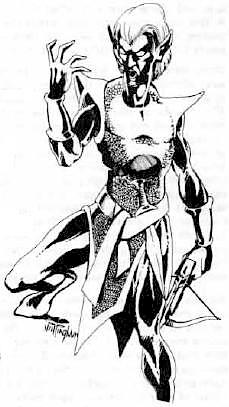
The drow or dark elves are a dark-skinned and white-haired subrace of elves connected to the subterranean Underdark in the Dungeons & Dragons fantasy roleplaying game. The drow have traditionally been portrayed as generally evil and connected to the evil goddess Lolth. However, later editions of Dungeons & Dragons have moved away from this portrayal and preassigned alignment. More recent publications have explored drow societies unconnected to Lolth.

In the Dungeons & Dragons fantasy role-playing game, illithids are monstrous humanoid aberrations with psionic powers. In a typical Dungeons & Dragons campaign setting, they live in the moist caverns and cities of the enormous Underdark. Illithids believe themselves to be the dominant species of the multiverse and use other intelligent creatures as thralls, slaves, and chattel. Illithids are well known for making thralls out of other intelligent creatures, as well as feasting on their brains.

Vecna is a fictional character appearing in the Dungeons & Dragons fantasy role-playing game. Vecna has been named one of the greatest villains in Dungeons & Dragons.

Deities & Demigods, alternatively known as Legends & Lore, is a reference book for the Dungeons & Dragons fantasy role-playing game (D&D). The book provides descriptions and game statistics of gods and legendary creatures from various sources in mythology and fiction, and allows dungeon masters to incorporate aspects of religions and mythos into their D&D campaigns.
Tiamat is a supremely strong and powerful 5-headed draconic goddess in the Dungeons & Dragons role-playing game. The name is taken from Tiamat, a goddess in ancient Mesopotamian mythology. She is the queen and mother of evil dragons and a member of the default pantheon of Dungeons & Dragons gods. Her symbol is a five-headed dragon.
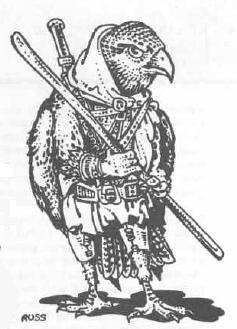
Kenku(pronounced keng-KOO or KENK-oo) are a fictional race of bird-like humanoid creatures in the Dungeons & Dragons fantasy roleplaying game. They have appeared in multiple editions in the game's history and became an official playable race in Volo's Guide to Monsters. They are loosely based on tengu, spiritual beings in Japanese mythology, and are most recognizable for their lack of a voice; instead of speaking themselves, they use their gift of mimicry to communicate. Jeremy Crawford, lead rules designer of the Dungeons & Dragons game, says "[they] can cleverly piece together voices and sounds they've heard to communicate".
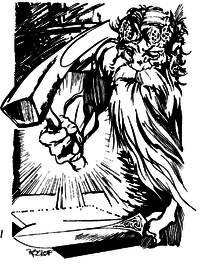
Moradin is the chief deity in the dwarven pantheon in the Dungeons & Dragons game and is a member of the default D&D pantheon. In 3rd edition, Moradin's domains are Creation, Earth, Good, Law, and Protection. The 5th Edition Players Handbook include Knowledge as a suggested domain. His titles include Soul Forger, Dwarffather, the All-Father, and the Creator. He created the first dwarves out of earthen materials and tutored them in dwarven ways.
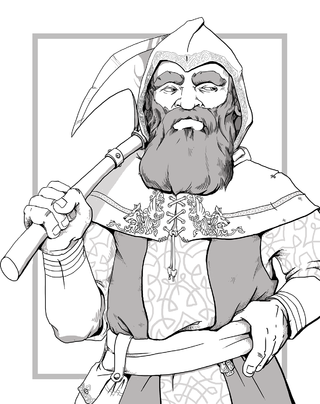
A dwarf, in the Dungeons & Dragons (D&D) fantasy roleplaying game, is a humanoid race, one of the primary races available for player characters. The idea for the D&D dwarf comes from the dwarves of European mythologies and J. R. R. Tolkien's novel The Lord of the Rings (1954-1955), and has been used in D&D and its predecessor Chainmail since the early 1970s. Variations from the standard dwarf archetype of a short and stout demihuman are commonly called subraces, of which there are more than a dozen across many different rule sets and campaign settings.
In the Dungeons & Dragons fantasy roleplaying game, Tharizdun is the god of Eternal Darkness, Decay, Entropy, Malign Knowledge, Insanity, and Cold. He originated in the World of Greyhawk campaign setting but has since also appeared in other settings.

Kobolds are a fictional race of humanoid creatures, featured in the Dungeons & Dragons roleplaying game and other fantasy media. They are generally depicted as small reptilian humanoids with long tails, distantly related to dragons.

In the Dungeons & Dragons fantasy role-playing game, goblins are a common and fairly weak race of evil humanoid monsters. Goblins are non-human monsters that low-level player characters often face in combat.

In the Dungeons & Dragons (D&D) role-playing game, Bahamut is a powerful draconic deity, who has the same name as Bahamut from Arabic mythology.

In the Dungeons & Dragons fantasy role-playing game, giants are a collection of very large humanoid creatures based on giants of legend, or in third edition, a "creature type".

The lich is an undead creature found in the Dungeons & Dragons (D&D) fantasy role-playing game. Liches are spellcasters who seek to defy death by magical means.
Tritons are a fictional species in the Dungeons & Dragons fantasy role-playing game.
The legion of fictional deities in the World of Greyhawk campaign setting for the Dungeons & Dragons fantasy roleplaying game covers an extensive range of spheres of influence, allowing players to customize the spiritual beliefs and powers of their characters, and as well as giving Dungeon Masters a long list of gods from which to design evil temples and minions. Although the Greyhawk campaign world, when it was merely a home game, started with no specific gods, the value of having deities available for both players and game plot purposes was quickly realized. The number of deities has varied with each version of the campaign world that has been published, but for many years numbered a few dozen. It has only been since 1999 that the number of gods increased dramatically to almost 200, due to the volume of newly published material that was subsequently integrated into the campaign world.
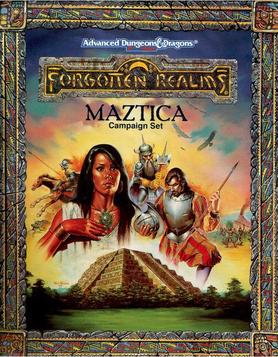
Maztica Campaign Set is an accessory for the 2nd edition of the Advanced Dungeons & Dragons fantasy role-playing game. The campaign set was co-authored by Douglas Niles and Tim Beach and published by TSR, Inc. in 1991.

In the Dungeons & Dragons role-playing game, Corellon Larethian is the leader of the elven pantheon, and the god of Magic, Music, Arts, Crafts, Poetry, and Warfare. Corellon is also considered a member of the default D&D pantheon. Corellon is the creator and preserver of the elven race, and governs those things held in the highest esteem among elves. Corellon's symbol was originally a crescent moon; in the 4th edition Corellon's symbol is a silver star on a blue field.
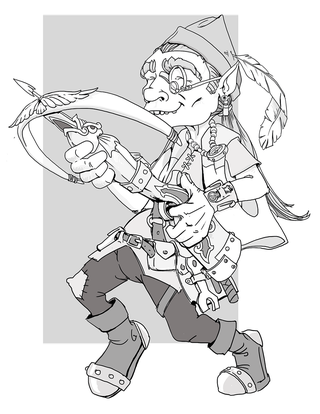
In the Dungeons & Dragons fantasy role-playing game, gnomes are one of the core races available for play as player characters. Some speculate that they are closely related to dwarves; however, gnomes are smaller and more tolerant of other races, nature, and of magic. Depending on the setting and subrace, they are often skilled with illusion magic or engineering. Gnomes are small humanoids, standing 3–3.5 feet (91–107 cm) tall.











